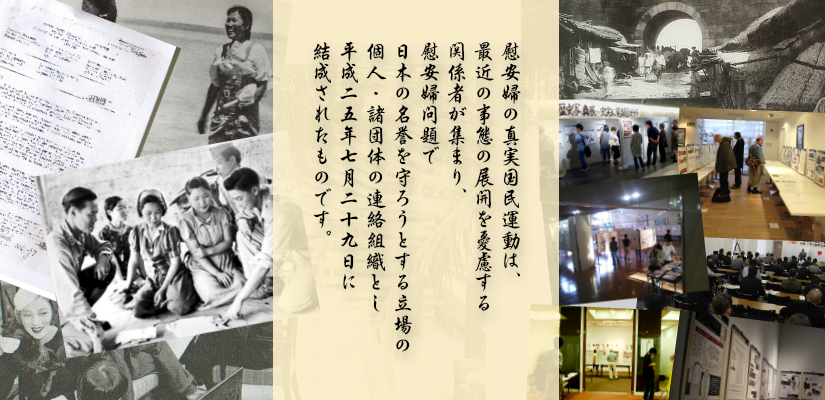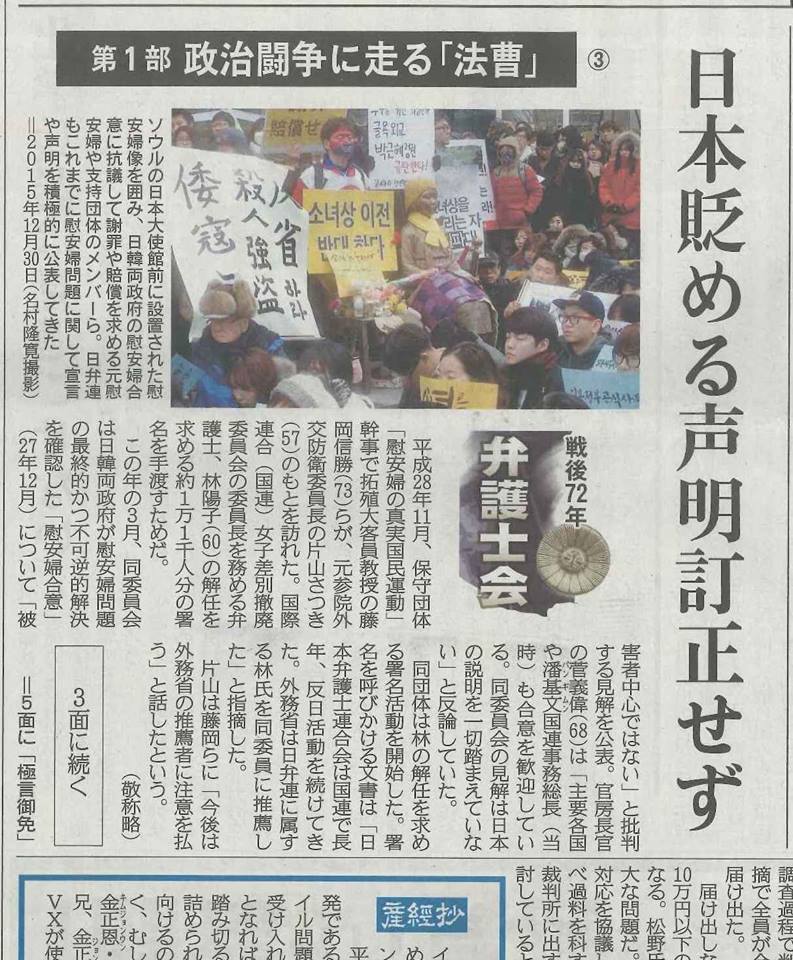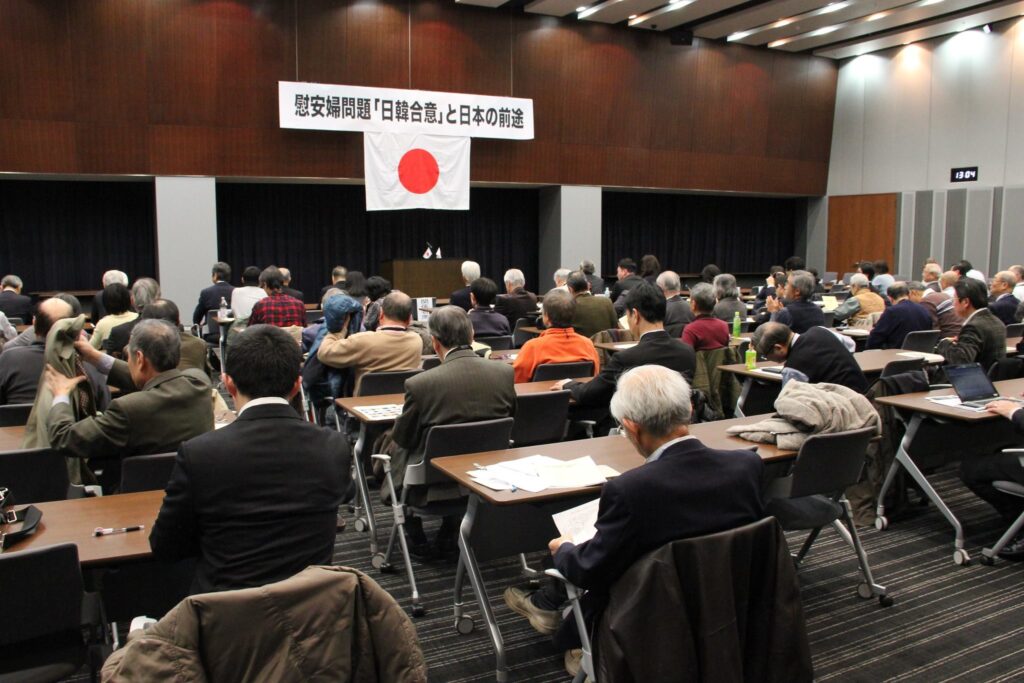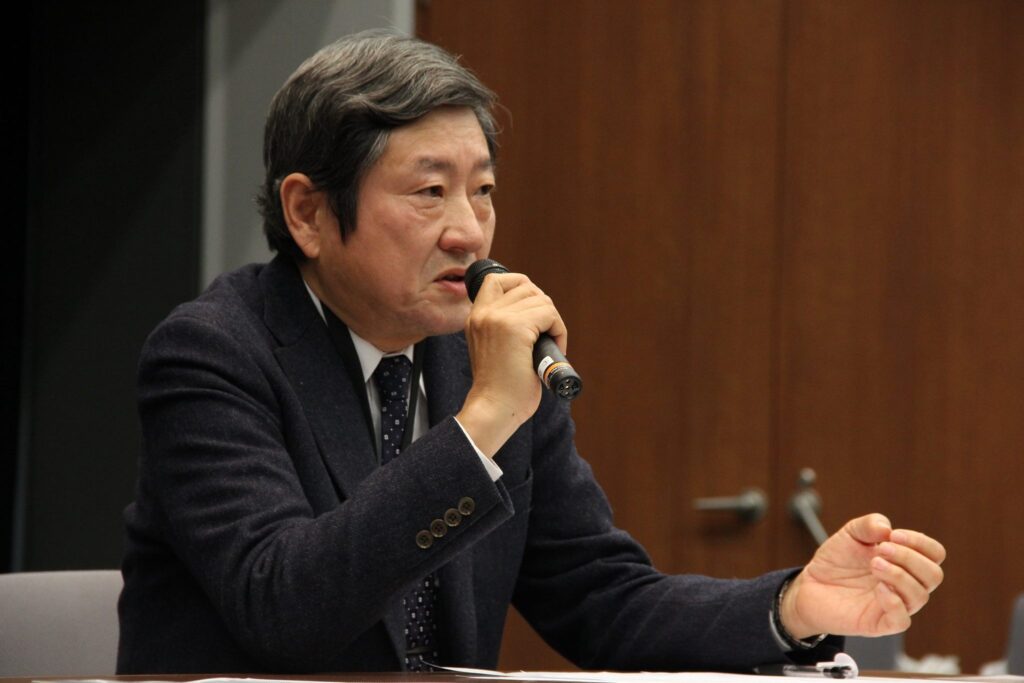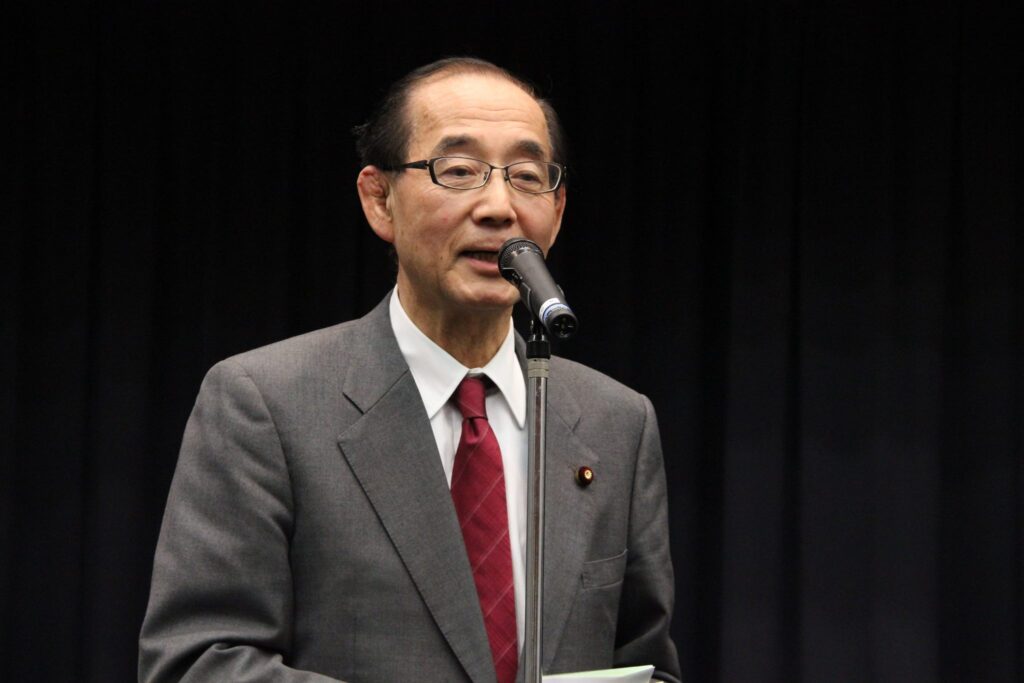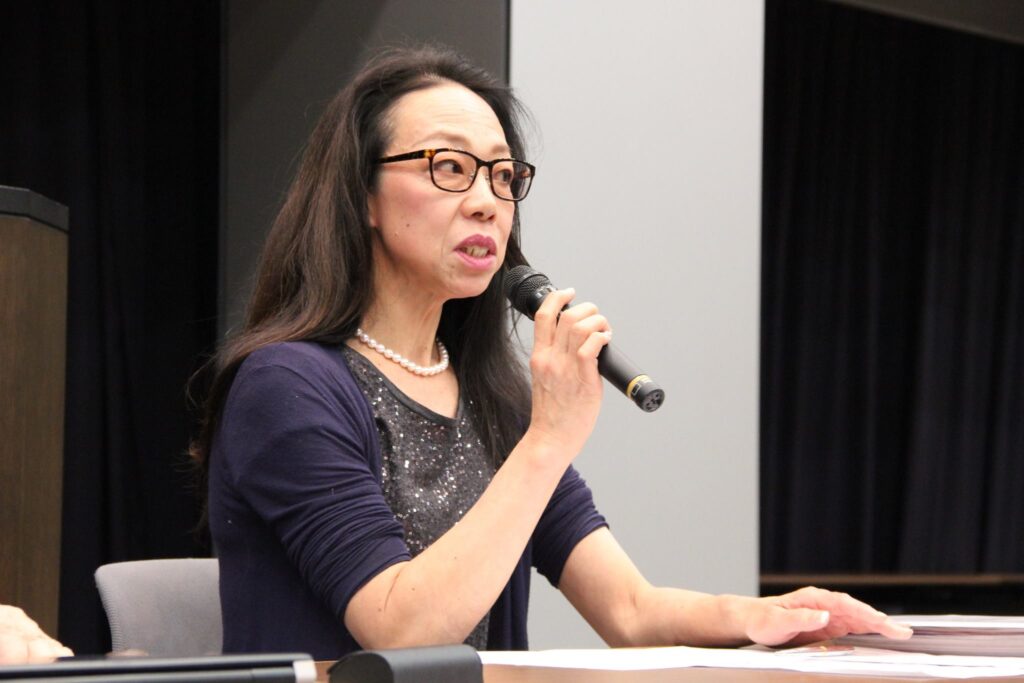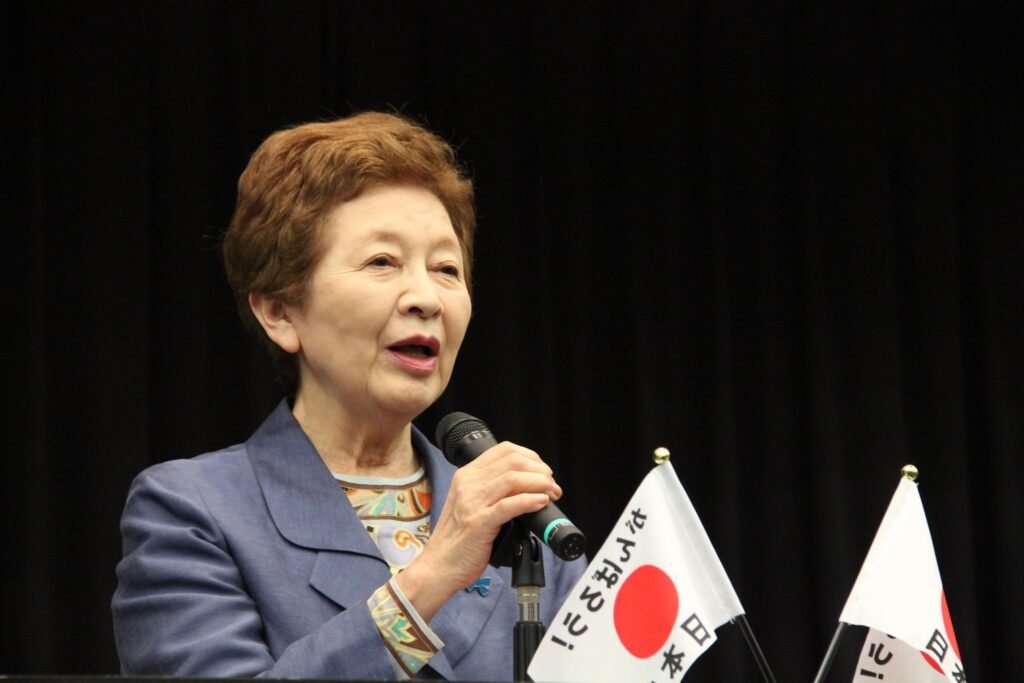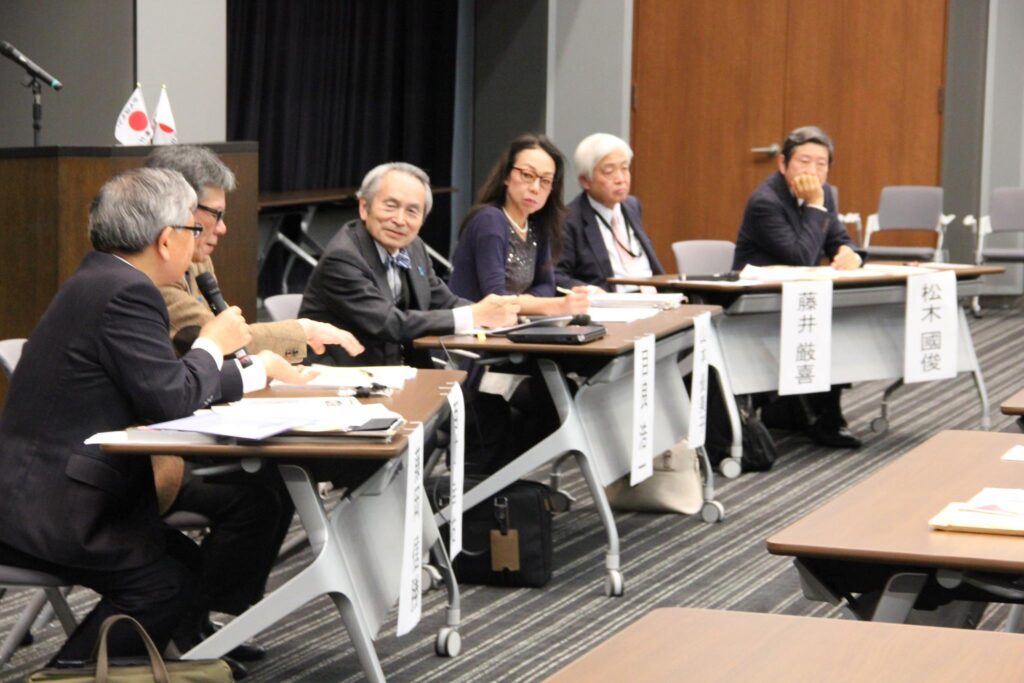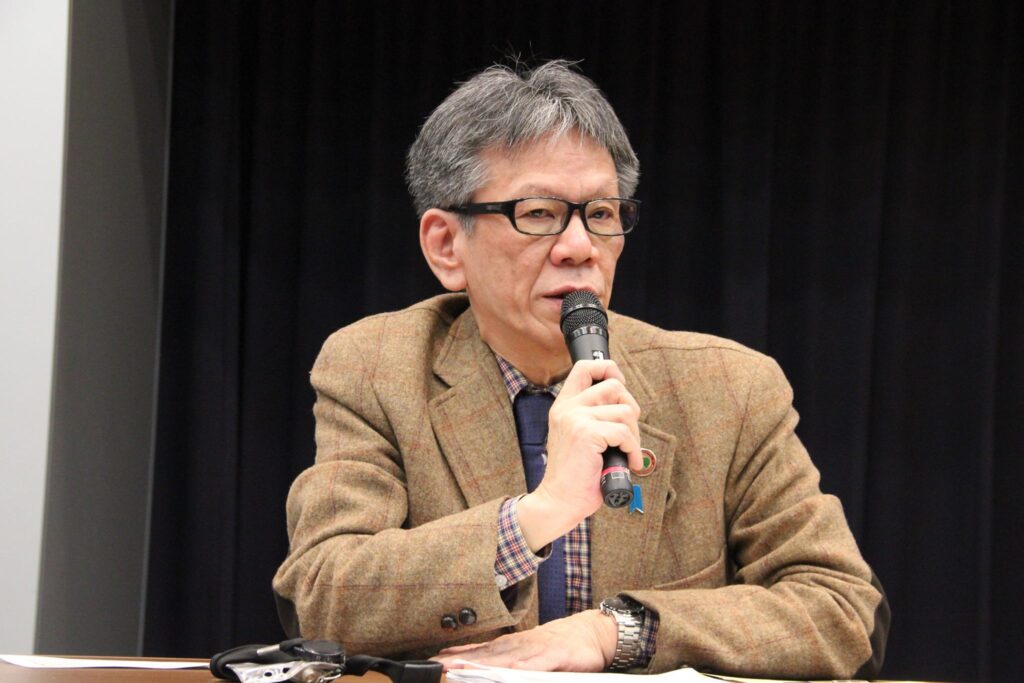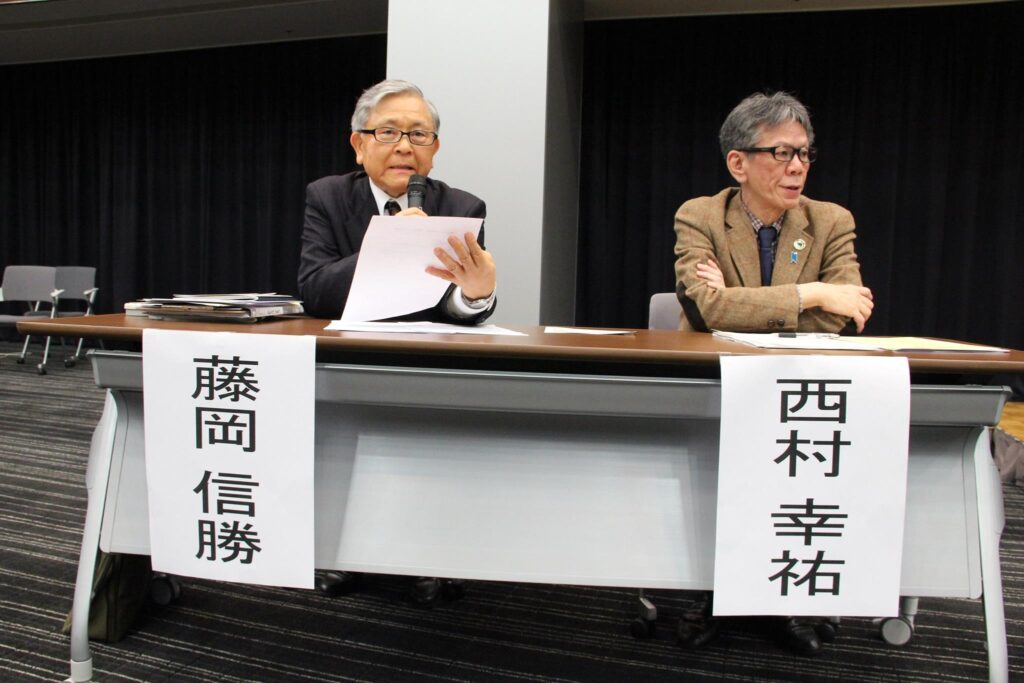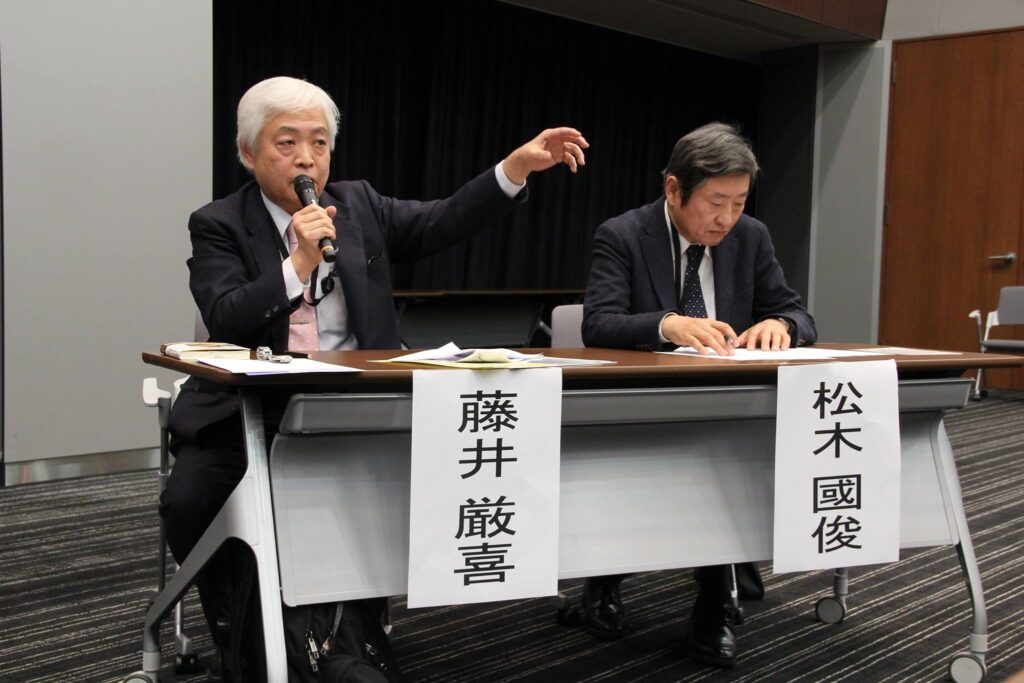June 12, 2015
A Counter Response and Proposal to
the”Open Letter” written by 187 Historians
By Fujioka Nobukatsu, Visiting Professor, Takushoku University
To the 187 historians who jointly signed the Open Letter,
On May 5, the “Open Letter in Support of Historians in Japan” was released and rapidly circulated around the world. This Letter was signed by 187 historians and researchers mainly in the field of Japan studies from the United States and western countries. The Open Letter accused the Japan’s military comfort women system before and during World War II. The Letter was a thinly veiled demand for an apology from the Prime Minister of Japan.
Note: As of the end of May, the number of signatures had grown to around 460, but out of respect for the original signatories I will only address the first 187.
I read the letter with an open mind, and, as a Japanese citizen, I would like to express my candid opinion. Please note that I do not represent any Japanese organizations or agencies, and the following is purely the personal viewpoint of a scholar who has been keeping abreast of the comfort woman issue since 1992.
My feelings of disappointment and encouragement
I experienced mixed feelings upon reading the Open Letter. On the one hand, I was disappointed, but on the other hand I was encouraged by the positive opportunity that the open letter presented.
I will first explain my disappointment. There are many well-respected scholars among the 187 historians and researchers who signed the Open Letter, including scholars who are very well-known in Japan. Some of their works have been translated into Japanese, and they have had a profound impact and influence on both Japanese scholars and lay readers.
Books written by the signatories, such as Ezra Vogel’s “Japan as Number One”, John Dower’s “War without Mercy”, Andrew Gordon’s “A Modern History of Japan”, and Ronald Dore’s “Education in Tokugawa Japan” have been translated into Japanese, and this was just a random sampling off the top of my head. In fact some of these translated works have been more widely read in Japan than in the country in which they were written!
The signatures of such scholars, it seems to me, added weight to the Open Letter. But, if you expect, by their presence, it would lead to gaining more support from a greater number of Japanese, I am afraid that you have decidedly failed to understand the perception prevailing in Japan over the comfort women issue. The significant portion of the Japanese people will never share the basic premise of the Letter.
I say this because there are simply too many people in Japan who have already reached their own understanding about the “comfort women” and suspect the whole comfort women story might have been fabricated as a political tool to attack Japan. For example, the fact that criticism of Japan regarding the comfort women issue might be built on a very flimsy factual basis became apparent following the newspaper Asahi Shimbun’s retraction last August of its thirty-two years’ worth of bogus reporting. This now-retracted reporting is a very large part of what started the whole comfort women story.
Therefore, any Japanese person with minimal awareness of the controversy who reads this Open Letter, including even an ordinary salaryman or housewife with no special academic qualification, would feel that the Letter is based fundamentally on a misconception of historical reality.
However, I must also write about my other reaction to the Open Letter, in that I feel that its release represents a great opportunity. As I noted previously, it is my opinion that Japanese citizens on the whole are better informed about the reality of the “comfort women” problem than are American-based “Japan Specialists,” and this means that our two nations have become divided, not only by the vast expanse of the Pacific Ocean, but also by an equally vast “information gap” on certain subjects.
And yet, I do not believe that all of the Open Letter’s signatories supported it out of ill will or bias towards Japan. The contents of the statement never descend into prejudice and consistently adopt an attitude of fairness. It is plain to see that its authors exercised discretion and attempted to base their statement on universal values. For instance, one portion of the Open Letter read as follows,
“Postwar Japan’s history of democracy, civilian control of the military, police restraint, and political tolerance, together with contributions to science and generous aid to other countries, are all things to celebrate.”
As a Japanese citizen, I am pleased and highly grateful to the signatories of the Letter for their recognition of the value of Japan’s contributions to world peace since the end of World War II.
As a whole, this Open Letter appealed to universal values of democracy, liberty, and human rights. I concur wholeheartedly with these principles, which, indeed, should be cherished above anything else. It is precisely because of the importance of these universal values that one should fight against prejudice and bias based on historical misconceptions and attempt instead to maintain one’s fairness and objectivity.
However, the “Open Letter in Support of Historians in Japan” has exposed the information gap that exists between Japan and the United States, thus presenting us with an excellent opportunity to close it. I am writing this letter in the hope of making a small contribution towards filling that information gap.
Errors in the McGraw-Hill textbook
One example of this information gap appeared in November and December of last year, when the Japanese government asked for corrections to be made in a world history textbook in use at American high schools, McGraw-Hill’s “Traditions and Encounters.” The request was made on the grounds that the book’s description of the Japanese Army comfort women was highly inappropriate. Nineteen American historians then struck back with a message published in a US academic bulletin criticizing the actions of the Japanese government.
On March 17, in response to the nineteen American historians, nineteen Japanese historians pointed out what they felt were grievous factual errors in the textbook’s description of the comfort women, and they, too, politely asked McGraw-Hill to have the errors corrected.
The Japanese historians who authored the statement, represented by Professor Hata Ikuhiko, a leading expert on the comfort women issue, summarized the textbook’s mistakes in eight areas. I will outline four of them here:
(1.) The textbook stated, “The Japanese army forcibly recruited, conscripted, and dragooned as many as two hundred thousand women,” but the only Japanese scholar who the nineteen American historians cited as endorsing their viewpoint was Yoshimi Yoshiaki, who stated on a Japanese TV talk show that, “There is no evidence for forced recruitment of comfort women on the Korean peninsula.” The nineteen American historians seemed not to be aware of this.
(2.) Concerning the number of comfort women, the textbook gives the figure of “as many as two hundred thousand.” However, Professor Hata estimates the true number at around 20,000, based on documentary evidence including statistics compiled by Japanese government agencies.
(3.) The textbook states that “the ‘comfort women’ catered to between twenty and thirty men each day,” despite having already declared that the total number of comfort women was 200,000. If this is the case, then Japanese soldiers received between four million and six million sexual services per day. The total overseas troop strength of the Japanese Army requiring such services was one million, at warfare peak in 1943, meaning that each soldier went to a comfort station four to six times per day, according to the textbook. At this rate, Japanese Army soldiers would have had no time to prepare for battle or even live normal lives.
(4.) The textbook claimed that, “At the end of the war, soldiers massacred large numbers of comfort women to cover up the operation.” It is doubtful that this statement is based on historical documentary evidence. If it was, then a case should have been taken up by the postwar Tokyo Trials or by one of the B/C-class war crimes trials, and yet there is no record of that having occurred. It should go without saying that one cannot write in a textbook where, when, and how many people were killed without any supporting evidence. The textbook has thus portrayed a possibly baseless accusation as being an undisputed historical fact. Teaching American students in this manner is not truth-seeking but is instead an imposition of propaganda, a practice which is contrary to both freedom of scholarship and freedom of thought.
The written request by the nineteen Japanese historians (which I also signed) to correct the textbook’s errors was immediately sent to McGraw-Hill. Though we have yet to receive a reply, the newspaper Sankei Shimbun reported on May 16 that McGraw-Hill had responded to a question from one of its correspondents, indicating that it had no intention of making any corrections. Thus, McGraw-Hill has made no effort to confront the facts presented by reputable Japanese historians, so the Japanese government has every reason to object to the teaching to American high school students of what the Japanese consider to be lies.
Even though our written request did not make McGraw-Hill change its ways, it seems that it did have some impact on the academic community after all. I say this because the message of the nineteen American historians made reference to “state-sponsored sexual slavery”, but that expression does not appear anywhere in the “Open Letter.” Nor does that Open Letter mention the textbook’s figure of 200,000 comfort women. These were significant changes from the insistence of the nineteen American historians that the numbers used in the textbook not be altered.
The actual results of the military’s “systematic management”
However, even though the open letter of May 5 does show some progress towards common sense, both of the statements by foreign scholars still view the comfort women system in fundamentally the same way. Their basic viewpoint can be summed up in the following quote from the Open Letter:
“Among the many instances of wartime sexual violence and military prostitution in the twentieth century, the ‘comfort women’ system was distinguished by its large scale and systematic management under the military, and by its exploitation of young, poor, and vulnerable women in areas colonized or occupied by Japan.”
Before making a single country the target of such sweeping criticism, a considerable amount of careful, fact-based research and analysis of comparative data should be a prerequisite. My question to the signatories of the Open Letter is, “Did you undertake a careful investigation of this sort before producing your statement?” To shed light on this matter, I would now like to take another look at several of the claims made by the Open Letter.
First of all, concerning its scale, I already mentioned that there is a controversy over whether the number of women working within the Japanese Army’s comfort women system was closer to 200,000 or to 20,000. Here the Open Letter simply states that the number of comfort women “will probably never be known for certain” and makes no attempt to pursue the matter further. How could the Open Letter have concluded that “the ‘comfort women’ system was distinguished by its large scale” if the scale “will probably never be known for certain?”
Secondly, the phrase “systematic management under the military” is simply a misunderstanding. The comfort women were hired by brokers who ran the brothels. The working conditions of comfort women may have been harsh, but they were paid high wages. At the time, a Japanese Army private first class soldier earned 10 yen per month, while a comfort woman in Burma was making an average of 750 yen per month. Comfort women who worked for a whole year were even able to buy new houses for their parents back at home. The essence of the wartime comfort women system was the extension of peacetime brothels onto the battlefield. Their customers were Japanese soldiers.
The fact that the comfort women were paid prostitutes rather than sex slaves was fully acknowledged by an official report of the US Army. “Japanese Prisoner of War Interrogation Report No. 49,” written by the US Office of War Information Psychological Warfare Team in Burma, states right in its opening preface that, “A ‘comfort girl’ is nothing more than a prostitute or ‘professional camp follower’ attached to the Japanese Army for the benefit of the soldiers.”
The Japanese Army’s involvement in the comfort women system extended into three areas: signing contracts with and giving permits to brokers for the establishment of comfort stations, enacting regulations at those comfort stations, and having army doctors administer regular health checkups for the comfort women. The objective of the Japanese Army’s regulation of the comfort stations was to protect the rights of comfort women by imposing safeguards on exploitative brokers. Without the Army’s involvement, the working conditions of the comfort women would probably have been a lot worse. Both the relationship between the Army and the brokers and the relationship between the brokers and the comfort women were governed by contracts, and thus it was a lawful system comparable to those of contemporary nations which regulates public prostitution.
The comfort stations were put in place with the twin goals of keeping the sexual urges of frontline soldiers in check so that they would not harm local women and preventing the spread of venereal diseases from the use of local, already established brothels.
The tendency among American historians is to view military involvement as an unprecedented and impermissible policy. In the United States, it was typical for military personnel to take advantage of established, local brothels. For example, there was a red-light district in Hawaii called “Honolulu Street,” where prostitutes brought in from San Francisco took one hundred customers daily. The United States even made use of brothels that the Japanese government set up for American soldiers during the postwar US occupation. Likewise, since the start of the Korean War, American soldiers stationed in South Korea used local brothels that the Korean Government set up.
Nevertheless, this merely represents a difference in customs between our two nations, and it does not change the fact that the objective of both systems was to find a way to manage the sexual urges of soldiers near the battlefield. The Japanese comfort women system was itself based on the system created by Germany during World War I. American historians have taken the United States’ own special method of wartime sexual management and upheld it as the perfect model, criticizing all other methods used by other countries. This is actually a naive sort of national chauvinism.
By way of comparison, the American method, involving the use of local brothels, suffers from its failure to control the risk of contracting venereal diseases. For instance, US Army units stationed in Kunming, China, used local brothels in the early 1940s, and as a result almost half of their soldiers and mechanics were stricken with sexually transmitted diseases and unable to work. In situations where battlefield conditions were harsh, like during the Vietnam War, the US Army created brothels under its virtually direct control when local brothels were unavailable.
The Japanese comfort women system was generally successful at achieving its designated goals. There were almost no rapes perpetrated by Japanese soldiers in occupied areas and few children of mixed nationality were left behind by the Japanese Army.
By contrast, American soldiers who had been stationed in Japan after the war left a great number of mixed-raced children behind them through liaisons with Japanese women. In Vietnam, the children of South Korean soldiers and Vietnamese women are known as Lai Dai Han, and there are estimated to be several tens of thousands of them.
Turning our attention back to World War II, the largest incident of mass rape occurred during the capture of Berlin by the Soviet Red Army. About one million German women were raped by Soviet troops, and it is said that 200,000 of them died. Many children were produced through acts of rape by Soviet forces. The Red Army also raped and massacred Japanese women in Manchuria immediately after the surrender of Japan. As an instance of wartime sexual violence in the twentieth century, why haven’t the 187 historians taken up these transgressions, given that the scale of the atrocities was far greater?
It is certainly not true that Japanese men have unusually high sex drive in comparison to other people. Comparative data have consistently ranked Japanese males as being less lustful than other people in the world.
Fake atrocity stories and the credibility of testimonies
The third point I want to bring up is the claim in the Open Letter that, “the ‘comfort women’ system was distinguished by… its exploitation of young, poor, and vulnerable women in areas colonized or occupied by Japan.” This is a major misconception. Most of the Japanese Army’s comfort women were prostitutes from Japan. Hata Ikuhiko’s calculation breaks down the total number of comfort women as being forty percent from Japan, thirty percent from the local area of occupation, twenty percent from Korea, and ten percent from other places. The number of Japanese and Korean comfort women was proportional to their relative populations.
It is likely true that these women were poor and vulnerable, and, if we imagine their individual circumstances, all of them deserve sympathy. However, it would be wrong to assume that the comfort women system cruelly forced them into a fate more inhumane than the alternatives. Women working in brothels in peacetime are also poor and vulnerable, and some former comfort women have even recalled that they sought out the army for more favorable conditions, which they felt were preferable to peacetime brothels.
Fourthly and finally, I will spend some time discussing one issue which I am certain influenced the thinking of the scholars who signed the Open Letter, and that is the “testimonies” and its credibility of former comfort women, in the context of wartime sexual violence. One can see in parts of the Open Letter that its signatories accepted that unbelievably cruel acts were perpetrated in the Japanese Army’s comfort stations and that the comfort women were victims of sexual violence. The Open Letter refers to the “brutalization” of comfort women and states that they were “subjected to horrific brutality” by the Japanese Army.
In 1996 the United Nations Human Rights Council approved the Coomaraswamy Report, which included the following testimony from Jeong Ok-sun, a North Korean who claimed to be a former comfort woman:
“[The Japanese soldiers] took off her clothes, tied her legs and hands and rolled her over a board with nails until the nails were covered with blood and pieces of her flesh. In the end, they cut off her head. Another Japanese, Yamamoto, told us… ‘since those Korean girls are crying because they have not eaten, boil the human flesh and make them eat it.'”
Japanese people would find stories like this ridiculous. Japanese people do not engage in such morbid habits and, of course, have never practiced cannibalism as a custom. These sorts of tales can be found abundantly in Chinese history books, which, in turn, have had a cultural impact on the Korean Peninsula. The former comfort women are simply relating stories based on those shared in common by nations within the Chinese cultural sphere.
It was also written in a resolution passed by the US House of Representatives in 2007 that “mutilation” was one of the brutal deeds perpetrated by the Japanese military. Mutilation or dismemberment was a terrible punishment traditionally practiced in the Chinese Emperor’s harem, but it has never been practiced in Japan. Anyone who is a real expert on Japanese history and culture would surely support me in this statement.
The first former Korean comfort woman to testify about her experiences did so in 1991, more than forty years after the end of the war, and since then over fifty have come forward. Even so, not one of them has convincingly claimed that they were forcibly recruited without contradicting themselves. There are even some former comfort women who have said that, “I was taken to a comfort station in a jeep”, or “We were especially busy around Christmas time.” The Japanese Army had no jeeps, much less celebrated Christmas, so we have no choice but to conclude that the “victimizers” of these comfort women were American soldiers, not Japanese soldiers.
Therefore, using the testimony of comfort women as evidence just because they tug at our heartstrings (and they surely do tug at our heartstrings) cannot be permitted in any society governed by the rule of law. Allowing untested testimonies to prevail against Japan can only be described as discrimination against Japanese.
My proposal for academic conferences
The signatories of the Open Letter aspire to make sexual violence a thing of the past and to forge a world where human rights will be respected by all. I have no reason to question their motives, and in fact I share in this agenda and completely support it. Still, in pursuit of such aims, I do not quite understand why the signatories have chosen to deal with and condemn only the Japanese comfort women system, which ceased to exist more than seventy years ago.
To this day, we confront the existing reality that girls from poor families in Southeast Asia are sold and sent around the world, including to the United States, suffering from sexual abuse. China is engaging in large-scale ethnic persecution in Tibet and Xinjiang, which includes assaulting women. In North Korea’s concentration camps for political prisoners, some inmates are subjected to dreadful sexual torture. Following the recent earthquake in Nepal, sex traders went to work, and it was reported by British media that 15,000 Nepalese girls were sold off to places like India and South Korea.
In order to truly create a world without sexual violence, should not our work be focused on preventing the far more urgent crimes that are ongoing as I write these words? Japan would surely provide financial assistance and humanitarian aid in support of this goal. Is there any reason why the Japanese Army’s alleged mistreatment of the comfort women over seventy years ago, which may not have even occurred, is an issue that is more important than the violations of women’s rights which are happening around the world at this very moment? I sincerely hope that the “Open Letter” was not being influenced by the Korean and Chinese “nationalist invective” that it criticizes.
In conclusion, I would like to propose that a series of serious academic conferences be held between Japanese and American scholars in order to have a dialogue on issues like the nature of the Japanese Army’s comfort women system, international comparisons on how nations managed their soldiers’ sexual activity on the battlefield, and the serious human rights problems plaguing the world today. The tone of the discussion would be dispassionate and scholarly, based on evidence and logical analysis.
The Japanese Ministry of Foreign Affairs could provide a forum for such a discussion, or, alternatively, it might be preferable if a private foundation took the initiative. There is no better time than now to have a mutual dialogue through which we can learn from one another. Together we can make the twenty-first century a “Century of Hope.”
Note: Most of this letter was previously published in the Japanese language magazine Seiron, July 2015 issue. However, this English language letter was modified from the Japanese version for addressing an American audience.
「187人の歴史家声明」に対する応答と提案
2015年6月12日
拓殖大学客員教授 藤岡信勝
声明署名者187人の歴史家の皆様へ
5月5日、「日本の歴史家を支持する声明」が公表され、たちどころに世界中に広がりました。声明には、アメリカと西洋諸国の歴史家と日本研究者187人の署名があり、第二次世界大戦までの日本軍慰安婦制度を指弾するものでした。声明は、あからさまではないにせよ、日本の総理大臣の謝罪を求めていることが透けて見えるものでした。
*注記 その後、署名者は5月末現在460人程度に増えましたが、当初の人数を尊重して宛名を変更しません。
私は日本国民の一人として、この声明を真摯に受けとめた上で、率直な意見を述べてみたいと思います。以下の見解は、日本のいかなる機関や組織も代表するものではなく、あくまで、1992年以来慰安婦問題を注視してきた私個人の見解であることをお断りしておきます。
皆様の声明に接した私は、自分の中で、2つの異なる思いが交錯するのを感じました。一つは落胆であり、一つは好機到来の希望でした。
まず、落胆の事情から書きます。署名した187人の歴史家・日本研究家の中には、日本でも著名な、尊敬すべき方々が数多く含まれております。それらの方々の著作は日本語に翻訳され、日本の研究者や一般読者に多くの感銘と影響を与えてきました。
すぐに思い出す日本語の翻訳書の著者と書名をランダムにあげてみると、エズラ・ヴォーゲル『ジャパン・アズ・ナンバーワン』、ジョン・ダワー『人種偏見』、アンドルー・ゴードン『日本の200年』、ロナルド・ドーア『江戸時代の教育』などです。この中には、実のところ出身地の本国でよりも日本でより多くの読者を獲得した書物も含まれています。
こうした方々が含まれているだけに、この声明は重みを増しているように思われますが、それによって声明が多くの日本人に受け入れられるはずだとお考えだとしたら、それは日本における現状を大きく見誤ったものと申し上げざるを得ません。
と申しますのは、多数の日本国民が、すでに慰安婦問題なるものについて理解してしまったからです。それは日本を政治的に非難するために捏造された問題であり、その問題をもとにした日本非難には事実の裏付けがないことが、特に昨年八月の、朝日新聞の32年間にわたる誤報記事の取り消しによって、誰の目にも明らかとなりました。
ですから、声明を読んでも、多少の知識のある日本人なら、特別の学究の徒ではない市井のサラリーマンや主婦でさえ、皆様の声明が誤った事実認識に基礎をおいて書かれているという感じを持つようになっているのです。
しかし、ここで私の中に起こったもう一つの感情、すなわち好機到来という思いについて書く必要があります。すでに述べたように、アメリカの「日本研究者」よりも、日本の、多少とも啓蒙された国民のほうが、慰安婦問題の真相を知っているということは、太平洋を挟んだ両国の間に、特定のテーマに関して巨大な「情報ギャップ」が生じているということを意味します。
私は声明文の署名者の全員が、日本に対する偏見と悪意をもって賛同したとは必ずしも受け取ってはおりません。声明文には、日本に対する偏見に陥らず、公正な立場を貫き、普遍的な価値に根ざそうとする配慮のあとが明瞭に見てとれます。声明は次のように書いています。
「戦後日本が守ってきた民主主義、自衛隊への文民統制、警察権の節度ある運用と、政治的な寛容さは、日本が科学に貢献し他国に寛大な援助を行ってきたことと合わせ、全てが世界の祝福に値するものです」
声明の署名者達が、戦後の日本の世界に対する平和的な貢献について、このように評価して下さったことに、日本人の一人として感謝の気持ちを表したいと思います。
声明は全体として、自由、民主主義、人権、などの普遍的な価値に根ざす立場にたっています。それらについては全く同感であり、これらの理念こそ、今、最も大切にしなければならないものです。だからこそ、間違った事実認識に基づく独断や偏見を排除することは、公平・公正な立場を堅持しようとする人の義務でもあります。
そこで、日米間の情報ギャップが露わになったこの声明は、そのギャップを埋めるための絶好の機会を提供するものでもあるのです。私のこの手紙も、その情報ギャップを埋めるささやかな一助になることを願って発信されるものです。
情報ギャップの一例が昨年の11月と12月に露呈しました。日本政府は、アメリカの高校生が使っているマグロウヒル社の世界史教科書『伝統と邂逅』に掲載された日本軍の「慰安婦」についての記述が極めて不適切である、として訂正を求めたのです。それに反発したアメリカの歴史家19人は、アメリカの学会誌に投書し、日本政府の動きを批判しました。
3月17日、アメリカの19人の歴史家に応えて、日本の19人の歴史家が、マグロウヒル社の教科書の「慰安婦」記述における事実の間違いを指摘し、それを正すように出版社に求める鄭重な訂正勧告を行いました。
慰安婦問題研究の第一人者・秦郁彦が代表となった右の声明文では、8件に限定して誤りを指摘しました。そのうちの4件をここで紹介してみます。
(1)教科書は、「強制的に慰安婦にされたり、徴用されたりした」と書いていますが、19人の歴史家が、連帯する相手方の日本の歴史家として唯一名前を挙げた吉見義明は、日本のテレビの討論番組で、「朝鮮半島における強制連行の証拠はない」と述べています。アメリカの19人の歴史家たちは大きな勘違いをしているようです。
(2)慰安婦の数として教科書は「20万人もの女性」と書いています。しかし、慰安婦研究の第一人者・秦郁彦教授は、日本の関係機関の統計などの資料に基づいて、2万人程度と推定しています。
(3)教科書は、「慰安婦が毎日20人~30人の男性を相手にした」と書いています。ところで、教科書によれば、慰安婦の総数は20万人でした。そうすると、日本軍は毎日、400万回~600万回の性的奉仕を調達したことになります。他方、日本陸軍の海外兵力は、戦争まっさかりの1943年で100万人でした。教科書に従えば、彼等は全員が「毎日、4回~6回」慰安所に通ったことになります。これでは戦闘準備をする時間はおろか、まともに生活する暇もなくなります。
(4)教科書は、戦争が終わると日本軍は、証拠隠滅のために「多数の慰安婦を大虐殺した」と書いています。この記述の根拠史料は何なのかが問われます。もしそういうことがあれば、東京裁判や各地のBC級軍事裁判で裁かれているはずですが、そういう記録はありません。何人を、いつ、どこで殺害したか、証拠がなければ教科書に書くことが適切でないのは言うまでもありません。証拠がないものを疑う余地のない歴史的事実として記述し、アメリカの生徒に教えることは、史実の追求ではなく、特定のプロパンガンダを植え付けることになり、学問の自由にも思想の自由にも反していると思われます。
私も署名した訂正勧告文書は、マグロウヒル社に直ちに送付しました。しかし、未だに同社からの回答がありません。ところが、5月16日付の産経新聞によれば、同紙の特派員の質問に対し、マグロウヒル社は、「訂正しない」旨の回答をしたとのことです。同社は著名な日本の歴史家が提示した事実に向き合う努力を全くしていません。だから、日本人から見れば嘘としか言えないことをアメリカの高校生に教えることに日本政府として異議を唱えるのは当然のことです。
私達の訂正勧告は、アメリカの教科書会社を改心させるに至っていませんが、さすがに学者の皆様には多少の影響を与えたものと見えます。というのは、19人の文書にあった「国営性奴隷制」という言葉が、187人の声明では消えているからです。教科書にあった「20万人」という数字も登場しません。19人は教科書の「20万人」という数字を含む慰安婦に関する記述を変えさせてはならない、と抗議していたのですから重要な変化です。
良識的判断の方向に向けての上記のような前進があるにもかかわらず、今度の声明でも、海外の学者の皆様の、日本の慰安婦制度についての理解は、基本的には変わっていません。その理解の核心は、次の一節に表現されています。
《20世紀に繰り広げられた数々の戦時における性的暴力と軍隊にまつわる売春のなかでも、「慰安婦」制度はその規模の大きさと、軍隊による組織的な管理が行われたという点において、そして、日本の植民地と占領地から、貧しく弱い立場にいた女性を搾取したという点において、特筆すべきものであります。》
一国をこのように断定して非難の対象とするからには、よほど慎重な事実の検討と、比較作業の積み重ねが必要です。質問しますが、皆様方はそのような慎重な作業をなさったのですか。この点に光を当てるため、声明の主張のいくつかを選んで、それを別の観点から検討してみたいと思います。
第一に、規模についていえば、すでに話題にしたように、日本軍の慰安婦制度のもとで働いていた女性の数は20万人だったのか、2万人だったのか、という事実をめぐる論争があります。これについて、声明は「恐らく、永久に正確な数字が確定することはないでしょう」と述べて、それ以上の追求を放棄しています。数字が確定しないのであったら、どうして日本の慰安婦が規模において特筆すべきものだという断定が可能なのですか。
第二に、「軍隊による組織的な管理」は誤解を与える表現です。日本の慰安婦は遊郭を経営する業者に雇われていました。慰安婦の仕事は過酷ではあったでしょうが、それに見合った高給が支払われていました。上等兵の月給が10円の時代に、ビルマでは平均月収750円でした。1年働けば、国元の親のために、家を何軒も買ってやることが出来るほどでした。平時の遊郭が戦地にまで営業地を延長したのが、日本軍の慰安婦制度の実質です。慰安所の顧客は日本軍の兵士達でした。
慰安婦が性奴隷ではなく、賃金を受け取っていた売春婦であることは、米軍の正式な報告書がハッキリと認めています。アメリカ戦時情報局心理作戦班のビルマ戦線における捕虜の尋問調書第49号は、「『慰安婦』とは売春婦以外のなにものでもなく、兵士のために日本軍に付属する『職業的追軍娼婦』であった」と冒頭に書いています。
軍隊が関与したのは、以下の3点、すなわち、慰安所の設置についての業者に対する認可と契約、慰安所の規則の制定、軍医による定期的な健康検査の実施です。慰安所の規則を軍が関与して制定したのは、強欲な業者の専横を抑え、慰安婦の権利を守るためでした。軍が関与しなければ、慰安婦の労働条件はもっと劣悪なものになっていたでしょう。軍と業者の間、業者と慰安婦の間はいずれも契約関係にあり、公娼制度が存在した当時の法律に照らして合法的なシステムでした。
慰安所設置の目的は2つあり、戦場における兵士の性欲処理をすることによって現地の女性に被害を与える可能性を取り除くことと、兵士が既存の売春施設を利用することで性病に罹患するのを防止することでした。
軍の関与があること自体を、前例のない許しがたい方針と見なす傾向がアメリカの歴史家にはあるようです。アメリカは現地の既存の施設を利用するのを常としていました。たとえば、ハワイには「ホテルストリート」と呼ばれる売春地帯があり、サンフランシスコから運ばれてきた売春婦達が、一日100人の客をとらされていました。また、アメリカは、戦後の日本占領期でも日本政府が米兵のためにつくった売春施設を利用しました。同様に、朝鮮戦争以来の駐韓米軍も韓国政府がつくった現地の施設を利用しました。
しかし、これはその国の慣習の違いにすぎず、戦場の兵士の性欲処理の機能を果たすものであることに変わりはありません。日本の慰安婦制度は、第一次世界大戦におけるドイツの制度を原型としたものです。様々な性欲処理方式のうち、自国の特定の方式だけを絶対化して、その方式と異なる方式を採用している国を批判するのは、素朴な自国中心主義の誤りです。
比較論として言えば、アメリカ式現地調達方式には、性病にかかる危険があるという弱点があります。例えば、1940年代の初めに中国の昆明にあった米軍基地では、現地の売春施設を利用したために、兵士や整備工の半数近くが性病にかかって動けなくなりました。また、アメリカはベトナム戦争のような過酷な戦場で、既存の施設が得られない場合には、事実上軍直営の施設をつくっています。
日本の慰安婦制度が所期の目的をほぼ達成したことは、現地での強姦事件が殆どなかったこと、また、現地の女性との混血児を残していないこと、などに表れています。
これに対して、日本を占領した米軍は日本女性との間に多数の混血児を残しました。ベトナム戦争で、韓国兵は現地にライダイハンと呼ばれる混血児を残しました。その数、数万と言われています。
視野を第二次大戦中に戻せば、最大規模の強姦事件は、ソ連のベルリン侵攻時に起こりました。約100万人のドイツ人女性がソ連兵により強姦され、その被害女性の20万人が亡くなったといわれています。また、多数のソ連兵の子供が強姦によって生まれました。ソ連は満州でも日本人女性多数を強姦し、殺戮しています。20世紀の性犯罪としては、これらのほうが遙かに巨大で深刻なのに、なぜ皆様はこの歴史を論じないのでしょうか。
比較の上で、日本人男性が特筆すべき強い性欲の持ち主でないことだけは確かです。その種の比較データによれば、いつも日本人男性は世界で最下位クラスに位置します。
第三にとりあげたいのは、声明が「『慰安婦』制度が際立っていたのは・・・日本の植民地と占領地から、貧しく弱い立場にいた女性を搾取したという点であった」と主張していることです。ここにも大きな誤解があります。日本軍の慰安婦は、多数が日本人売春婦によって占められていました。秦郁彦の試算では、慰安婦の出身地は、日本人4、現地人3、朝鮮人2、その他1、という割合になっています。日本と朝鮮の人口比に見合っています。
これらの女性が貧しく弱い立場にいたことは確かでしょう。個々のケースを想像すれば、誰についても同情の余地があります。しかし、彼女らの境遇をことさら過酷に、非人間的な境遇に置かれたかのように思い込むのも適切ではありません。そういうことを言えば、平時の遊郭で働く女性も、貧しく弱い立場にいたのです。軍隊はむしろ恵まれた環境として志願した慰安婦もいたし、戦地にいた時のほうが平時の遊郭よりも楽しかったと回想する元慰安婦もいるのです。
第四に、そしてこれが最後になりますが、声明に署名した学者の皆様が影響を受けていると考えざるを得ない一つの論点について申し上げます。それは、戦時性暴力に関する元慰安婦の「証言」の信憑性についてです。皆様の声明では、日本軍の慰安所でとんでもない残虐な行為が行われ、慰安婦は性暴力の犠牲者であったと信じている節が見受けられます。声明は慰安婦に対する「残虐行為」という言葉を使い、彼女達は軍による「恐ろしい残虐行為にさらされた」と書いています。
1996年、国連の人権委員会は「クマラスワミ報告」を承認しました。その中には、北朝鮮の元慰安婦と称するチョン・オクスンの次のような証言が含まれています。
《[日本兵は]慰安婦を全裸にし、両手両足を縛り上げ、沢山のクギを打ち付けた板の上を転がして、肉がクギに食い込んで平らになるまで拷問を続けた。最後には、彼等は彼女の首を切り落とした。山本という別の日本人が私達に言った・・・「こいつら朝鮮人の女が泣いているのはものを食っていないからだ、人肉を煮て食わせろ」》
こうした話を聞けば、日本人なら一笑に付します。日本人にはこうした猟奇的な趣味はなく、人肉食の習慣もありません。この類いの話は中国の史書にふんだんに載っているもので、朝鮮半島は中国文化圏に属します。元慰安婦は中国文化圏で共有されている知識をもとに語ったのです。
2007年に可決したアメリカ下院の決議には、「四肢切断」が日本軍による残虐行為の一つとして挙げられています。四肢切断は中国の後宮で行われた恐ろしい習慣で、日本には全く形跡のないことです。皆様が本当に日本の歴史や文化の専門家でいらっしゃったら、すぐに賛成いただけるはずです。
朝鮮半島の慰安婦の証言者が初めて名乗り出たのは、戦後40年以上経過した後の1991年で、それ以来証言者は50人を超えています。しかし、その中の誰一人として、強制連行されたことを矛盾なく述べた人物はいないのです。中には、「慰安所にジープで連れられていった」、「クリスマスの前後は特に忙しかった」などと証言している元慰安婦もいます。日本軍にはジープもクリスマスを祝う習慣もありませんでしたから、この場合、「加害者」は、日本兵ではなく、米兵という結論にならざるを得ません。
ですから、慰安婦の証言を、心に訴えるものがあるからといって証拠採用することは、法の支配が行われている社会では許されることではありません。日本に対する検証されていない証言をばらまくことは、日本人差別という以外に言いようがありません。
声明の署名者達は、この世から性暴力をなくし、人権が尊重される世界をつくろうとする希望を抱いています。その動機を疑う理由はありません。実際、私はその主張を共有し、完全に支持します。しかし、そうであれば、なぜ、署名者たちが、70年以上前に存在しなくなった日本の慰安婦制度だけをことさら取り上げて糾弾の対象とするのか理解に苦しみます。
今現在、東南アジアの貧しい少女がアメリカを含む各地に売られ、性暴力にさらされている現実があります。中国はチベットやウイグル地区で大規模な民族弾圧を行い、その中には女性への暴力も含まれています。北朝鮮では政治犯収容所などですさまじい性的迫害が行われています。最近起こったネパールの地震では、業者が暗躍し、1万5千人の少女をインド、韓国などに売り飛ばしているとイギリスのメディアが報道しています。
本当に性暴力のない世界をつくろうと考えるなら、現在進行中のこの事態を食い止める活動のほうが、はるかに緊急を要するのではないでしょうか。そのためには、日本は資金援助も人道援助も行うでしょう。現に今、この瞬間にも起こっている女性の人権侵害よりも、70年以上前の、なかったかも知れない日本軍の女性の虐待のほうが重要だという理由が何かあるのですか。この声明が、声明の中で批判されている中国や韓国の「民族主義的暴言」の影響を受けたものでないことを私は切に望んでいます。
結論として、私は最後に、日米の研究者の間の真摯な、一連の討論会の開催を提案します。テーマは、日本軍の慰安婦制度とは何であったのか、戦場の性処理問題の国際比較、現在の世界で繰り広げられている深刻な人権問題、などについてです。討論は、証拠と論理に基づく冷静で学術的なものとします。
そうした場を日本の外務省がつくってもいいし、民間の財団が旗を振っていただいてもよいと思います。相手の視点から学ぶ相互対話が今ほどふさわしい時はありません。私達が力を合わせれば、21世紀を「希望の世紀」とすることができるはずです。
*注記 この手紙の大部分は、日本語で、雑誌『正論』2015年7月号に掲載された。ただし、この英語の手紙は、アメリカの読者に向けてさらに手を入れて書き直したものである。
